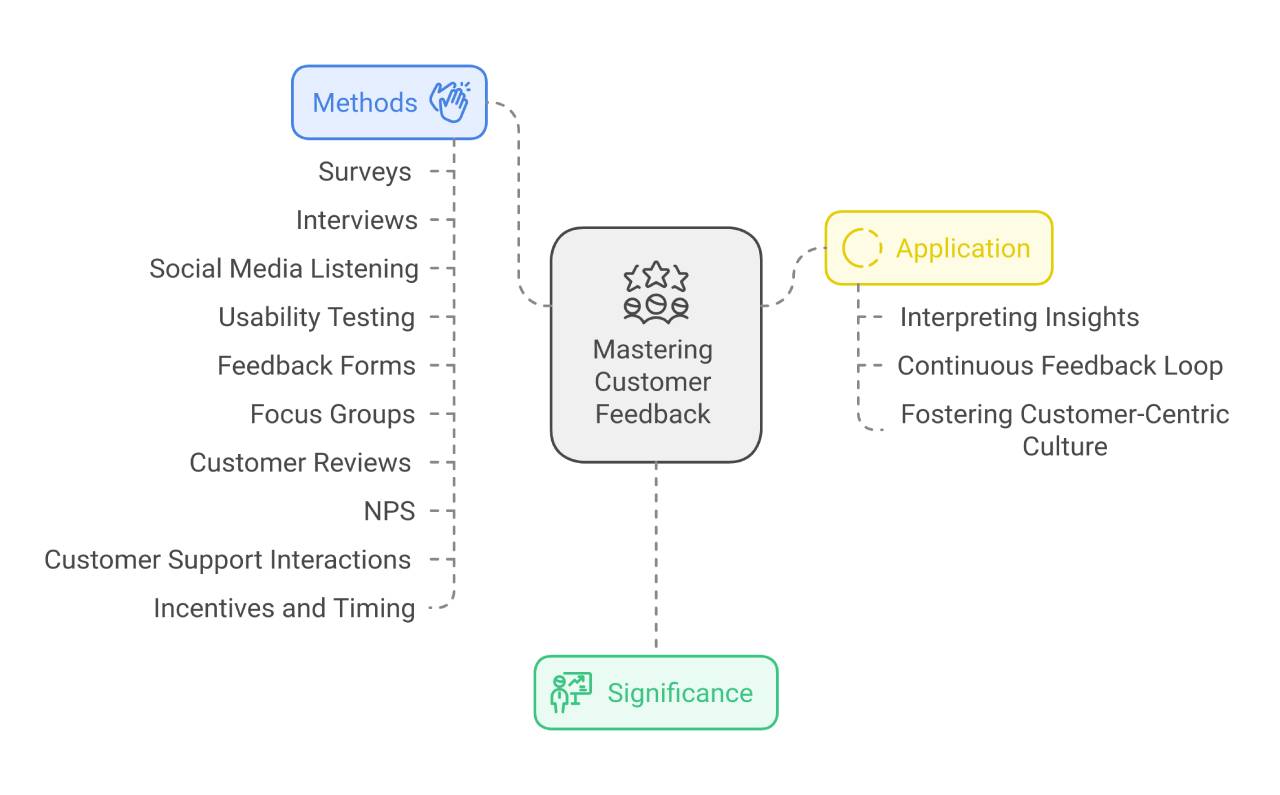Every voice matters, especially the voice of the customer. In the world of business, understanding what customers want can drive success. Gathering and acting on customer feedback is crucial for any thriving organization.
Effective feedback channels transform opinions into valuable insights. Various methods exist for collecting opinions, each bringing unique advantages.
These techniques help businesses listen, learn, and evolve based on genuine customer experiences.
This article will explore ten proven methods for mastering customer feedback. Each method will provide actionable strategies for deepening connections with your audience.
Let’s embark on this journey of listening and learning together!
Table of Contents
The Significance of Customer Feedback
Customer feedback is vital for business improvement. Understanding feedback helps shape customer-centric decisions and strategies. Happy customers lead to customer loyalty and repeat business.
Collecting feedback highlights areas needing attention. Addressing negative feedback reduces customer churn. This turns potential customers into loyal, lifelong fans.
Engaging with feedback builds trust between brand and customer. Customers feel heard and valued, increasing referrals. It fosters strong, valuable relationships.

Positive feedback boosts a company’s reputation. Testimonials attract new customers through word-of-mouth. This can significantly influence business success.
Feedback methods include:
- Customer feedback surveys
- Open-ended questions
- Customer interviews
- Email surveys
- App surveys
Utilize diverse methods for comprehensive actionable insights. Create a valuable experience throughout the customer journey. Regularly seek and act on user feedback for optimized customer satisfaction.
| Feedback Method | Benefit |
|---|---|
| Surveys | Gather actionable insights |
| Interviews | Deep dive into user experience |
| Open-ended | Uncover valuable feedback |
Method 1: Surveys – The Backbone of Gathering Insights
Surveys are essential for collecting valuable customer feedback. They provide specific insights businesses need. Tools like SurveyMonkey, Google Forms, and Typeform make surveys easy to create and share.
There are different types of surveys for different needs. These include Customer Satisfaction (CSAT) and Net Promoter Score (NPS). These surveys gather specific data for meaningful analysis.
Designing surveys properly is crucial for success. Use clear, concise questions to boost response rates and gather actionable feedback. This empowers your business to improve the customer experience.
Surveys can capture various feedback metrics. These include customer satisfaction scores and other useful insights. Well-crafted surveys unlock a trove of valuable information about customer opinions.
Remember to use a mix of question types. Use both multiple-choice and open-ended questions. This approach gathers a broad range of insights from your customer base.
Surveys fuel businesses with the information they need. This enables better decision-making and customer journey improvement. Actively seek feedback to enhance satisfaction and loyalty.
Method 2: One-on-One Interviews – Deep Dive Conversations
One-on-one interviews allow for a deeper dive into customer experiences. They offer a chance to ask follow-up questions, enriching the feedback.
These conversations reveal both verbal responses and non-verbal cues, providing context. Understanding these cues helps capture the truest customer sentiments.
Preparation is crucial for successful interviews. Active listening ensures no valuable insights are missed. Asking thoughtful, open-ended questions is vital, encouraging customers to open up.
These interviews often uncover detailed ideas not found in surveys.
Consider these interview essentials:
- Prepare thoughtful questions.
- Listen actively and note observations.
- Interpret non-verbal cues.
- Encourage detailed responses.
The richness of insights from one-on-one interviews is unmatched. They deepen the understanding of customer journeys and experiences. This method brings out actionable feedback, essential for improving customer satisfaction and loyalty.
Method 3: Social Media Listening – Tuning into the Digital Pulse
Social media listening is a powerful tool. It involves tracking platforms like Facebook and Instagram. You’re looking for mentions, reviews, and discussions. This helps understand customer sentiment and their experiences.
Here’s how it works:
- Monitor Conversations: Keep an eye on brand-related discussions.
- Analyze Feedback: Interpret what customers say about your services.
- Extract Insights: Discover user experience and expectations insights.
Using specialized tools can ease your workload. These tools capture authentic feedback efficiently. They help identify trends swiftly as they emerge.
Pros of Social Media Listening:
- Real-time trend identification
- Unfiltered user experiences
Challenges:
- Managing unstructured data
- Overcoming negative bias
- Ensuring follow-up
Despite challenges, the insights can be priceless. Authentic feedback leads to actionable insights. Recognize emerging trends for a better customer experience.
Here’s a brief table to show potential outcomes:
| Feedback Type | Insights Gained |
|---|---|
| Positive Feedback | Strengths to capitalize |
| Negative Feedback | Areas for improvement |
| Neutral Observations | Potential customer desires |
Social media listening keeps your brand tuned in. It helps you connect deeply with your audience.
Method 4: Usability Testing – Observer Insights in Action
Usability testing lets brands see customer interactions firsthand. It provides direct insights into user experience. Observers watch how customers handle specific tasks. This reveals usability strengths and weaknesses.
This method uncovers friction points in products. Users navigate while observers note struggles. The feedback is specific and actionable. It’s incredibly valuable for improving user experience.
Usability testing adapts to different environments. Conduct sessions remotely or in-person. This flexibility enhances feedback collection. It caters to varied user preferences.
Regular testing helps monitor long-term experiences. It highlights accessibility across demographics. Observing users over time provides context. Brands can better understand user struggles.
Benefits of Usability Testing:
- Reveals friction points and improvement areas
- Provides specific, actionable feedback
- Flexible: Remote or in-person sessions
- Monitors long-term user experiences
Usability tests give crucial insights and improve user journeys. Investing in this method enhances customer satisfaction. It’s a powerful tool for loyal customer retention.
Method 5: Feedback Forms – Simple Yet Effective Tools
Feedback forms are a powerful tool for businesses. Placed at the bottom of each webpage, they offer great clarity.
A single question keeps the process simple and quick. Customers can give feedback without feeling overwhelmed by long surveys.
Strategically positioning these forms enhances interaction and response rates. Feedback forms should appear on key pages for maximum visibility.
This placement is key to receiving valuable feedback. Engaging with customers in real-time improves the customer experience significantly.
Post-purchase feedback collection prevents distractions during browsing. This method safeguards potential sales opportunities and allows for immediate issue resolution.
Overall, feedback forms are crucial in refining user experience and nurturing customer loyalty.
Key Benefits of Feedback Forms:
- Simple design encourages more responses
- Enhances real-time customer interactions
- Protects sales during the shopping journey
- Gains actionable insights for business improvement
- Quickly resolves issues, boosting customer satisfaction
Method 6: Focus Groups – Collaborative Evaluation
Focus groups bring customers together. They discuss wants, needs, and perceptions. This leads to valuable, qualitative insights.
Participants collaborate, building on each others’ thoughts. This makes discussions richer than individual interviews.
Focus groups explore various issues like brand messaging. They help with product solutions and strategic decisions. Moderators play a crucial role here. They clarify and expand responses. They probe deeper and capture non-verbal cues.
This method complements quantitative research effectively. It adds personal experiences to the data. Stories provide context to numerical survey findings. Focus groups offer human nuances often missed in surveys.
Key Benefits of Focus Groups:
- Richer discussions
- Exploring diverse issues
- Valuable qualitative insights
- Deeper understanding through moderation
Focus groups are essential for comprehensive customer feedback. They bridge the gap between numbers and human experience.
Method 7: Customer Reviews – Learning from Public Opinions
Customer reviews on digital platforms build brand trust. They influence potential customers’ perceptions, creating authority. Engaging with these reviews offers valuable insights into public sentiment.
Responding empathetically to reviews shows you care. This makes unhappy customers feel heard and valued. Addressing their concerns can turn negative feedback into positive outcomes.
Public reviews reveal customer satisfaction levels. Businesses can identify improvement areas or reinforce successful practices. Monitoring these channels is crucial for real-time issue resolution.
Here’s how to leverage customer reviews:
- Monitor reviews regularly for actionable insights.
- Respond promptly and empathically.
- Use feedback to enhance the customer journey.
Engage with feedback and boost your brand reputation!
Method 8: Net Promoter Score (NPS) – Measuring Loyalty
Net Promoter Score (NPS) measures customer loyalty effectively. It asks a simple question: “How likely are you to recommend us?” Customers rate their likelihood on a scale from 1 to 10.
Companies with high NPS lead their industry in growth. This score helps identify loyal customers and potential brand advocates.
Using NPS, businesses gain valuable insights into customer enthusiasm. It highlights both positive feedback and negative feedback.
Identifying brand advocates opens new business opportunities. This approach nurtures valuable relationships and boosts customer loyalty.
The simplicity of NPS surveys makes them easy to use. Quick and straightforward, they gather actionable feedback.
This clarity allows for efficient customer feedback collection yet yields a high response rate.
Benefits of NPS:
- Identifies brand advocates
- Provides clear, actionable insights
- Boosts growth and customer loyalty
By integrating NPS into customer engagement strategies, companies can effectively enhance customer experience. With focus on improvement, NPS enables greater customer satisfaction and business success.
Method 9: Customer Support Interactions – Real-Time Feedback
Customer service feedback plays a crucial role. It shapes a company’s reputation and growth. Listening to customers reveals how reliable a business is.
Quick feedback requests about interactions help assess problem resolution speed. Accurate delivery insight is also gained.
Real-time feedback mechanisms make all the difference. They ensure companies can respond quickly and efficiently. Timely responses enhance customer trust and satisfaction.
This approach significantly improves the customer experience. Ultimately, it fosters unrivaled customer loyalty.
Using these insights is key to success. They guide improvements in support operations. Policies can be fine-tuned based on real-time feedback.
This makes services more efficient and customer-focused. Viewing real-time insights builds a better customer journey.
Real-Time Feedback Methods
- Live Chat Feedback: Ask questions via chat for instant opinions.
- On-Call Ratings: Gauge satisfaction during or after support calls.
- App Surveys: Launch surveys post-interaction within apps.
- Social Media Monitoring: Keep track of comments and messages.
Real-time feedback turns customer concerns into actionable insights. It helps turn unhappy customers into loyal fans. Real-time strategies transform feedback into valuable, actionable steps for improvement.
Method 10: Incentives and Timing – Enhancing Response Rates
Method 10 focuses on incentives and timing. Offering incentives, like discounts or loyalty points, boosts survey responses.
A charitable donation can increase responses by nearly 30%. This encourages customers and ensures valid results.
Single-question surveys are highly effective. Their simplicity leads to higher response rates. These could be customer satisfaction or recommendation surveys.
For a successful survey, consider clear, simple messaging. Personalized invitations make customers feel valued.
Timing is crucial; distribute surveys when they’re most likely to be noticed. Timely reminders to non-respondents can further increase participation.
Use exit intent pop-ups for last-minute feedback. This captures insights just as users leave. It’s a crucial moment for gathering honest responses.
Respect their time and efforts! Keep feedback methods customer-centric.
Here’s a list to boost response rates:
- Offer attractive incentives.
- Use clear, concise messaging.
- Send personalized invites.
- Choose optimal timing for distribution.
- Provide timely follow-up reminders.
- Utilize exit intent pop-ups for immediate feedback.
Categorizing Feedback: Structured vs. Unstructured Formats
Categorizing feedback into structured and unstructured formats is crucial. Structured feedback often comes from customer feedback surveys.
This feedback can be quantified with metrics like the Net Promoter Score (NPS). It gives a clear gauge of customer loyalty and satisfaction.
Unstructured feedback captures diverse emotions and experiences. It’s spontaneous and often comes as user feedback or open-ended questions.
This type provides deeper insights into the customer journey and experience.
Both types of feedback overlap, offering a broad view of customer opinions. Businesses can gain actionable insights by combining them. Analyzing both helps improve customer satisfaction and experience.
Comparison Table:
| Feedback Type | Characteristics |
|---|---|
| Structured Feedback | Solicited, measurable, benchmarked (e.g., NPS) |
| Unstructured Feedback | Unsolicited, emotional, broad experiences |
Understanding these differences enhances product management. It supports informed decisions based on valuable feedback.
Effectively categorizing feedback ensures the right teams get the right information. This process fuels improved customer satisfaction and loyal customer relationships.
Interpreting Insights: Turning Data into Actionable Strategies
Interpreting customer feedback is crucial for business success. Feedback should be transformed into actionable strategies. Employing skilled research teams is essential.
They analyze feedback and present it clearly to teams. Bar graphs and pie charts make data easy to digest.
Identifying common pain points is vital. Addressing these issues shows customers you care. This leads to better customer experiences.
The goal isn’t just collecting feedback. It’s making meaningful improvements based on it.
Here’s how to turn insights into action:
- Gather and organize feedback data.
- Use visuals for clear presentation.
- Identify recurring customer pain points.
- Prioritize issues for immediate action.
- Implement changes and monitor outcomes.
This process builds customer loyalty and satisfaction. Happy customers become your biggest promoters.
So remember, feedback is your ticket to a better customer journey. Turn insights into strategies, and watch your business thrive!
The Continuous Feedback Loop: A Cycle of Improvement
The continuous feedback loop revolutionizes organizational growth. Listening to customer feedback addresses hidden issues quickly.
This approach reduces customer churn effectively. Regular updates and reports reinforce feedback’s importance. Such transparency promotes cross-department collaboration.
Embracing a structured feedback culture is essential. It fosters openness and values customer perspectives.
With this, companies achieve continuous improvement. Enhanced product offerings naturally follow suit.
Effective feedback analysis requires a thoughtful process. Responses should be carefully categorized. Analytical tools help visualize valuable insights.
Developing action plans based on these insights is crucial.
To implement a feedback loop, follow these steps:
- Collect and categorize customer opinions.
- Use analytical tools for data visualization.
- Share insights across departments.
- Develop actionable plans from insights.
- Monitor changes and repeat the loop.
This cycle creates a powerful feedback-driven environment. It leads to improved processes and customer experience, boosting loyalty.
Closing Thoughts: Fostering a Customer-Centric Culture
Embracing customer feedback is vital for business growth. It unlocks insights into customer preferences and pain points.
Implement multiple feedback methods to capture diverse experiences. Satisfaction surveys, social media listening, and customer interviews are effective tools.
Challenges like feedback overload and bias require careful management. Prioritize actionable insights for product and service improvement.
Develop a well-defined feedback strategy to gather valuable insights. This approach can significantly enhance customer satisfaction and loyalty.
Respond proactively to feedback to build strong customer relations. Engage with unhappy customers to turn their experiences around.
Positive feedback is also crucial for understanding successful areas. A responsive approach can boost retention and transform potential into loyal customers.
In summary, a customer-centric culture thrives on constant feedback. It drives innovation and strengthens the entire customer journey. Commit to improving user experience for sustained success.





